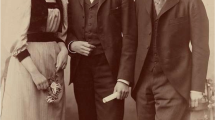Abstract
Arabo-Islamic physicians demonstrated exceptional skill and innovation in surgery, by having used the instruments introduced by ancient Greeks and Greco-Roman surgeons. In many cases they have manufactured their own innovative designs promoting further the success of the difficult surgical operations of their era. The surgical instruments and the surgeon’s boxes, used to regularise the plethora of the metallic items, were decorated with fine designs, in order to depict the Arab civilisation. For the first time surgery became a separate medical art, while Arabo-Islamic medicine re-introduced ancient Greek and Byzantine surgery to the world.












Similar content being viewed by others
References
Salah Sayour “Surgical scalpel” in Discover Islamic Art, Museum With No Frontiers, 2016. http://www.discoverislamicart.org/database_item.php?id=object;ISL;eg;Mus01;47;en
Najjar J (2010) From anaesthetic sponge to nonsinking skull perforator, unitary work neurosurgery in the ancient Arabic and Islamic world. World Neurosurg 73(5):587–594
Nasr SH (1968) Science and civilization in Islam. New American Library Incorporation, New York
Tsoucalas G, Karamanou M, Koutsilieris M, Nikolopoulos T, Laios K, Androutsos G (2016) The Arabo-Islamic contribution to the development of surgical instruments. Arch Balk Med Union 51(1):95–97
Milne JS (1907) Surgical instruments in Greek and Roman times. Clarendon Press, Oxford
Hippocrates. De natura muliebri & De mulierum affectibus i-iii & De visu (ed. É. Littré), Oeuvres complètes d’Hippocrate, vols. 7-9. Baillière: Paris, France, 7:1852 & 8:1853 & 9:1849 (repr. Amsterdam: Hakkert, 1962)
Cabana C, Bennouna M (1996) La médecine au temps des califes. Institut du monde Arabe, Paris
Meri JW (2005) Medieval Islamic civilization: an encyclopedia. Routledge, New York, p 784
Stroumsa S (1999) Freethinkers of Medieval Islam: Ibn Al-Rawandi, Abu Bakr Al-Razi and Their Impact on Islamic Thought. Brill, Leiden
Dipsy F (1996) The Ear, Nose and Throat in Rhazes’s Medicine. Proceedings of the 16th International Conference on History of Sciences: United Arab Emirates, December 1996
Singer C, Underwood AA (1962) A short history of medicine, 2nd edn. Oxford University Press, New York
Arani MG, Fakharian E, Ardjmand A, Mohammadian H, Mohammadzadeh M, Sarbandi F (2012) Ibn Sina’s (Avicenna) Contributions in the Treatment of Traumatic Injuries. Trauma Mon 17(2):301–304
Haq I, Khatib HA (2012) Light through the dark ages: the Arabist contribution to Western ophthalmology. Oman J Opthalmol 5(2):75–78
Pormann PE, Savage-Smith E (2007) Medieval Islamic Medicine. Edinburgh University Press, Edinburgh
Ayduz S., Sabuncuoglu O. The 15th Century Turkish Physician Serefeddin Sabuncuoglu Author of Cerrahiyetu l-Haniyye. http://www.muslimheritage.com, retrieved 08/01/2015
Turgut M (2008) Semseddin-i Itaki’s contributions to neuroanatomy and embryology in the seventeenth century. Childs Nerv Syst 24(11):1281–1282
Çetkin, M., Orhan, M., Bahşi, İ. et al. Childs Nerv Syst (2016): doi:10.1007/s00381-016-3136-9
Rooney A (2012) The history of Medicine. The Rosen Publishing Group, New York
Khan SM (2013) Islamic Medicine. Routledge, New York, p 88
Essa A, Ali O. Studies in Islamic Civilization: The Muslim Contribution to the Renaissance. International Institute of Islamic Thought (IIIT), Herndon, 2010: 124
Author information
Authors and Affiliations
Corresponding author
Ethics declarations
Conflict of interest
None.
Rights and permissions
About this article
Cite this article
Tsoucalas, G., Sgantzos, M. A Historical Glance at the Arabo-Islamic Surgical Instruments During the Ages. World J Surg 41, 1636–1645 (2017). https://doi.org/10.1007/s00268-017-3910-1
Published:
Issue Date:
DOI: https://doi.org/10.1007/s00268-017-3910-1




